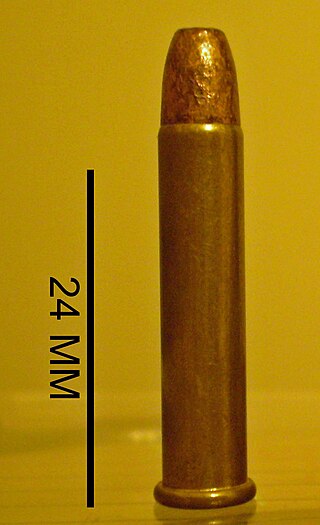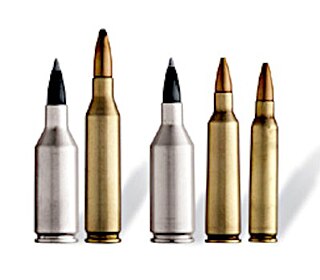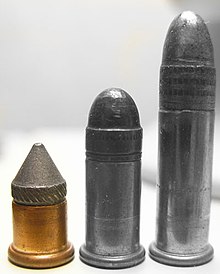
A cartridge, also known as a round, is a type of pre-assembled firearm ammunition packaging a projectile, a propellant substance and an ignition device (primer) within a metallic, paper, or plastic case that is precisely made to fit within the barrel chamber of a breechloading gun, for convenient transportation and handling during shooting. Although in popular usage the term "bullet" is often used to refer to a complete cartridge, the correct usage only refers to the projectile.
Muzzle velocity is the speed of a projectile with respect to the muzzle at the moment it leaves the end of a gun's barrel. Firearm muzzle velocities range from approximately 120 m/s (390 ft/s) to 370 m/s (1,200 ft/s) in black powder muskets, to more than 1,200 m/s (3,900 ft/s) in modern rifles with high-velocity cartridges such as the .220 Swift and .204 Ruger, all the way to 1,700 m/s (5,600 ft/s) for tank guns firing kinetic energy penetrator ammunition. To simulate orbital debris impacts on spacecraft, NASA launches projectiles through light-gas guns at speeds up to 8,500 m/s (28,000 ft/s). FPS and MPH are the most common American measurements for bullets. Several factors, including the type of firearm, the cartridge, and the barrel length, determine the bullet's muzzle velocity.

A rimfire cartridge is a type of firearm metallic cartridge whose primer is located within a hollow circumferential rim protruding from the base of its casing. When fired, the gun's firing pin will strike and crush the rim against the edge of the barrel breech, sparking the primer compound within the rim, and in turn ignite the propellant within the case. Invented in 1845, by Louis-Nicolas Flobert, the first rimfire metallic cartridge was the .22 BB Cap cartridge, which consisted of a percussion cap with a bullet attached to the top. While many other different cartridge priming methods have been tried since the early to mid-19th century onwards, such as pinfire, only small caliber rimfire and centerfire cartridges have survived to the present day with regular usage. The .22 Long Rifle rimfire cartridge, introduced in 1887, is by far the most common ammunition in the world today in terms of units manufactured and sold.

The .22 Long Rifle, also known as the .22 LR or 5.6×15mmR, is a long-established variety of .22 caliber rimfire ammunition originating from the United States. It is used in a wide range of firearms including rifles, pistols, revolvers, and submachine guns.
Internal ballistics, a subfield of ballistics, is the study of the propulsion of a projectile.

.22 BB Cap, also known as the 6mm Flobert, is a variety of .22 caliber rimfire ammunition. Invented by Louis-Nicolas Flobert in 1845, it was the first rimfire metallic cartridge. The .22 BB Cap and .22 CB Cap are interchangeable and are relatively quiet low velocity cartridges, designed for indoor target shooting.

.22 Short is a variety of .22 caliber (5.6 mm) rimfire ammunition. Developed in 1857 for the first Smith & Wesson revolver, the .22 rimfire was the first American metallic cartridge. The original loading was a 29 or 30 gr bullet and 4 gr of black powder. The original .22 rimfire cartridge was renamed .22 Short with the introduction of the .22 Long in 1871.

The .22 Long is a variety of .22 caliber (5.6 mm) rimfire ammunition. The .22 Long is the second-oldest of the surviving rimfire cartridges, dating back to 1871, when it was loaded with a 29 gr (1.9 g) bullet and 5 gr (0.32 g) of black powder, 25% more than the .22 Short on which it was based. It was designed for use in revolvers, but was soon chambered in rifles as well, in which it gained a reputation as a small game cartridge.

The .22 Winchester Magnum Rimfire, also known as the .22 WMR, .22 Magnum, .22 WMRF, .22 MRF, or .22 Mag, is a rimfire cartridge. Originally loaded with a bullet weight of 40 grains (2.6 g) delivering velocities in the 2,000 feet per second (610 m/s) range from a rifle barrel, .22 WMR is now loaded with bullet weights ranging from 50 grains (3.2 g) at 1,530 feet per second (470 m/s) to 30 grains (1.9 g) at 2,200 feet per second (670 m/s).

.17 Hornady Magnum Rimfire, commonly known as the .17 HMR, is a rimfire rifle cartridge developed by Hornady in 2002. It was developed by necking down a .22 Magnum case to take a .17 caliber (4.5 mm) projectile. Commonly loaded with a 17 grain projectile, it can deliver muzzle velocities in excess of 775 m/s (2,650 ft/s).
The .204 Ruger is a centerfire rifle cartridge developed by Hornady and Ruger. At the time of its introduction in 2004, the .204 Ruger was the second-highest velocity commercially produced ammunition and the only centerfire cartridge produced commercially for bullets of .204 inch/5 mm caliber.

The 243 Winchester Super Short Magnum or 243 WSSM is a rifle cartridge introduced in 2003. It uses a .300 WSM case shortened and necked down to accept a .243in/6mm diameter bullet, and is a high velocity round based on ballistics design philosophies that are intended to produce a high level of efficiency. The correct name for the cartridge, as listed by the Sporting Arms and Ammunition Manufacturers' Institute (SAAMI), is 243 WSSM, without a decimal point. Winchester has discontinued the manufacture of 243 WSSM ammunition. As of the first half of 2016, Winchester/Olin did manufacture and release for sale some WSSM ammunition. The product is only manufactured periodically, often at inconsistent intervals.

The .41 Rimfire Cartridge was first introduced by the National Arms Company in 1863 and was also known as the .41 Short and the .41-100. In most designations like this, the second number refers to the black powder load, though in this case it means "41 hundredths of an inch".

Snake shot, rat shot or dust shot, more formally known as shotshell or canister shot by technicality, refers to handgun and rifle cartridges loaded with lead shot canisters instead of bullets, intended for pest control. As the names suggest, the main targets for such ammunition are snakes, rodents, birds, and other pests at very close range.

.22 caliber, or 5.6 mm caliber, refers to a common firearms bore diameter of 0.22 inch (5.6 mm) in both rimfire and centerfire cartridges.

The .22 Extra Long is a .22 in (5.6 mm) American rimfire rifle and handgun cartridge.

The term .32 rimfire refers to a family of cartridges which were chambered in revolvers and rifles in the late 19th and early 20th centuries. These rounds were made primarily in short and long lengths, but extra short, long rifle and extra long lengths were offered.
A gallery gun, Flobert gun, parlor gun or saloon gun is a type of firearm designed for recreational indoor target shooting. These guns were developed in 1845, when French inventor Louis-Nicolas Flobert created the first rimfire metallic cartridge by modifying a percussion cap to hold a small lead bullet. In the 19th century, gallery guns were typically pump-action rifles chambered in .22 Short. Gallery guns are still manufactured, although by the late 20th century, they have been eclipsed by airguns for the purpose of indoor shooting.

Louis-Nicolas Flobert (1819–1894) was a French inventor. He invented the first metallic rimfire cartridge in 1845. It was a major innovation in firearms ammunition technology, as it was previously delivered as separate bullets and gunpowder, pertaining to muzzle-loading firearms. The rimfire cartridge combined both elements in a single metallic cartridge containing a percussion cap, gunpowder, and a bullet, into a single weatherproofed package or container. Before that, a "cartridge" was simply a pre-measured quantity of gunpowder together with a ball (bullet), in a small cloth bag, which also acted as wadding for the powder charge and ball.














